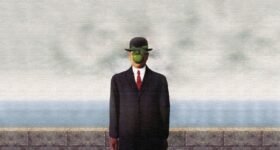
Sergio Leone’s Desert of Absurdity: Extracting the Existential Philosophy of “The Good, The Bad & The Ugly”
Sergio Leone’s Desert of Absurdity: Extracting the Existential Philosophy of “The Good, The Bad & The Ugly”
Once upon a time in the old wild west, an artist would have painted the world he knew as an endless desert embellished with cutting cacti, rugged rocks and the sparse traces of a traumatised society in the form of scattered, ramshackled towns with bleak wells, empty churches and a running knot on a desolate tree. Riding on their resilient horses while chanting ballads, through this nihilistic desert of solitude would be the iconic gunslingers, cowboys and bounty hunters of the age who lay in an endless struggle to seek the key to their existential freedom in an undefined world of undefined rules. This is the landscape that effectively embodies the cinematography of the Great Western Films, such as those of Sergio Leone’s. Amidst the echoes of galloping horses, firring gun shots and civil war screams, these films encapsulate stories that defined this unsteady era and through a retrospective perspective, the story of America itself as it evolved from a primeval cowboy society to a dynamic superpower that we now call the United States.
Directed by Italian filmmaker Sergio Leone and released in 1966, “The Good, The Bad and The Ugly” stands as arguably the greatest Western ever made, owing to its deceptively simple narrative that seamlessly amalgamates the aesthetics, ideals, and spirit of the Old Wild West. With its immaculate score by Ennio Morricone, exquisite cinematography by Tonino Delli Colli, and stellar performances by Eastwood, Wallach, and Van Cleef, the film earns its place as a cinematic masterpiece-a poignant reminder of the harsh realities of the Old West. In essence, the film follows three gunslingers-Blondie (The Good), Tuco (The Ugly), and Angel Eyes (The Bad)—as they navigate the tumultuous backdrop of the American Civil War in an unrelenting quest for a hidden cache of gold. Each character embodies distinct moral shades, weaving a complex tapestry of alliances and betrayals that culminates in an iconic three-way stand-off at a remote cemetery where the gold lies beneath an unmarked grave. While Westerns primarily entertain, they also serve as fertile grounds for analysis, offering profound themes and motifs that resonate deeply. In this review, I endeavour to unravel the layers of meaning within the film through a philosophical lens, exploring its existential and nihilistic underpinnings, and discerning their broader significance in the grand scheme of cinematic tradition.
The Absurdity of The West: No Order, No Meaning and No Purpose
Jean-Paul Sartre, famed for pioneering most ideas in existentialism addresses the concept of an absurd world in several of his works, particularly in “Being and Nothingness” and “Existentialism is a Humanism”. These ideas are consistent with the depiction of the Old Wild West in cinema which primarily characterises it as world devoid of inherent meaning, order and purpose that is not reinforced through any system of governance, nor a system of theocracy. Through this perspective, Tuco, Angel Eyes and Blondie can be all empathised as victims to this meaningless world as the navigate the abyss of the American desert in search for truth while simultaneously realising that the world they live in is deprived of a preordained plan or divine blueprint that would otherwise guide their human existence to actualisation. The Absurdity of the West is primarily embodied by three features that characterise the essence of this era: the lack of order, the lack of religion and the lack of purpose.
The lack of order is one reinforced through many anecdotes including the disunity among public institutions between counties over the hanging of Tuco, the power of bandits over the unionists, and the hedonistic behaviour of union officials as they indulge in death and drinking. In this gritty landscape, lawlessness reigns supreme, with no centralised authority to enforce justice or maintain order than the characters themselves who all work according to their own self-engineered moral compasses. The conflicting jurisdictions and arbitrary decisions regarding Tuco’s fate illustrate a lack of cohesive governance, where individual interests and power dynamics dictate outcomes rather than principles of fairness or legality. Moreover, the dominance of bandits over defenceless communities underscores the absence of protective institutions and the vulnerability of ordinary citizens to exploitation and violence. The hedonistic behaviour of union officials further reflects a moral vacuum, where those in positions of authority prioritise personal gratification over the welfare of the people they ostensibly serve. These examples paint the film’s world as one whose rules are arbitrary, law is futile and justice is elusive, leaving individuals to fend for themselves thus deducing the Sartrean definition of an absurd world as being devoid of order.
In the absence of a structured secular governance, one might expect a theocratic rule akin to the Middle Ages to dictate human existence. However, in “The Good, The Bad and The Ugly”, even religious institutions appear abandoned, adding a poignant layer to the absurdity of the Old Wild West. The depiction of religion is starkly evident in the dilapidated church where Tuco and Blondie seek refuge. Its shattered windows, crumbling walls, and decapitated statues of Christ amidst rusty crosses evoke a sense of spiritual decay amidst the anarchy that defines this universe. Tuco’s frequent signage of the cross during morally ambiguous situations, which one would see as being hypocritic, actually serves as a cynical commentary on the inefficacy of religion in providing meaning and guidance during times ravaged by war and hardship. Furthermore, the poignant exchange between Tuco and his priest brother underscores the confrontation between the people of the West, represented by Tuco, and the waning authority of God and religion, embodied by his priest brother. The outcome of this confrontation-Tuco striking his brother in response to a slap-symbolises the diminished influence of religion and its precarious position in governing a lawless land dominated by figures like the film’s titular characters. Moreover, it is the graveyard at the film’s resolution that stands as the most prominent testament to religion’s lingering presence. With its countless crosses marking graves in eerie stillness, it effectively symbolises the death of God and the fading relevance of religious institutions in guiding the anarchic world of the old wild west which logically justifies the chaotically immoral behaviours of the film’s titular charters.
From the anarchic governance and the fading church emerges a profound existential void among the ordinary folk navigating secluded hamlets and the endless deserts in the film. Echoing Sartrean existentialism, which asserts existence precedes essence, the characters in this absurd landscape confront a world where choices and judgments fail to imbue life with a meaningful essence. Unlike Sartre’s theory that individuals define essence through choices, the film’s context undermines any innate drive toward self-actualisation or transcendence. Secondary characters like Bill Carson and Angel Eyes’ employer, Baker, epitomise lives mired in mere survival rather than the pursuit of essence. Their existence is shaped by the harshness of their environment-war, scarcity, and lawlessness-forcing them to prioritise material needs over emotional fulfillment. This philosophical exploration portrays individuals constrained by circumstances, navigating a world where existential meaning takes a backseat to the relentless struggle for survival and material gain. However, the three titular characters challenge the notion that essence is irrelevant in this world. Amidst the chaos of improper governance, faded religion, and societal decay, they embody a drive to attain the cache of gold-a symbol of material wealth beyond the reach of secondary characters. In this lawless frontier, they pursue self-actualisation through the acquisition of wealth, conflicting with conventional standards where such pursuits would be deemed noble. In this harsh and individualistic world, their quest for gold represents symbolises an existential search for freedom and transcendence, that the titular characters are willing to taken even at the cost of the lives of others.
In summary, through existential reasoning, as guided by Sartrean ideas, we have discovered how “The Good, The Bad and The Ugly” vividly illustrates an absurd world that is devoid of inherent meaning characterised by its lack of structured governance, healthy religious institutions and struggle for basis necessities among the commoners. Amidst lawlessness and the decay of religion, the titular characters embody a stark contrast by individualistically pursuing material wealth beyond necessity as means of existential fulfillment. Consequently this ‘search for gold’ becomes the film’s definition of ‘self-actualisation’ or ‘living a life of essence’ which evidently challenges the conventional notions of self-actualisation being a noble endeavour in the modern world. In fact this landscape sets the backdrop for not just this film but all Western’s and can lead to further arguments such as the significance of morality within absurdity and how it leads to nihilism.
Radical Freedom and the Birth of Moral Nihilism
Similar to Sartre, Nietzsche argues that the world inherently lacks purpose and meaning, compelling individuals to construct their own moral codes of conduct and value hierarchies in order to deliver depth to their existence. Nietzsche’s concept of the “Übermensch” embodies this idea, depicting an individual who transcends social norms and embraces personal strength to assert freedom and authenticity. In the peculiar world of the Old West, where man is at the centre of his existence, detached from the idiosyncrasies of systematic rules, morals, and a Good God, he epitomises the “Übermensch” in the pursuit of self-interest. Through a Sartrean lens, it is in fact the ultra-absurdity of the west that instils the film’s titular characters with a form of radical freedom, allowing them to construct their own moral ethos, which they embrace in their existential quest for the cache of gold.
Blondie, “The Good,” adheres to a personal code of honour and justice. Despite his actions resonating moral ambiguity as we see later on, he demonstrates a consistent, albeit self-defined, sense of fairness. For instance, his decision to free Tuco from his noose at the film’s resolutions demonstrates his adherence to a personalised moral compass that embodies altruistic values such as prioritising human life over mere profit.
Meanwhile Tuco, “The Ugly”, carries a more chaotic and opportunistic moral compass that is governed by survival and self-interest exemplifying moral nihilism through his unpredictable actions and lack of consistent principles. But despite the moral ambiguity of his compass, he still embodies some degree of empathy particularly when he adheres to his alliance with Blondie or sympathises the death of mother, revealing to us that his decision pursue a life of crime was driven by his predicament between poverty and survival.
Lastly, Angel Eyes, “The Bad”, epitomises the darker corners of existential freedom. He constructs a moral framework centred around ruthless efficiency and personal gain. His unwavering pursuit of the gold, regardless of the cost to others, highlights a nihilistic detachment from conventional morality. His actions, such as cold-bloodedly killing his employer and abandoning his equipe encapsulates a complete rejection of traditional ethical constraints in favour of an unrelenting pursuit of power. However, despite his labelling, he still kills to meet his ends meet and unlike Leone’s other characters in the Dollars Trilogy like El Indio and Rajmon, Angel Eyes illustrates no signs of sadistic behaviour in that he derives hedonistic pleasure from the act of killing.
In summary, within the expanse of the Old Wild West that is devoid of divinity and law, the titular characters of “The Good, The Bad and Th Ugly” navigate this absurd world by forging their own paths to existential freedom that are guided by their own moral compasses. As consistent with the existential ideas of Nietzsche and Sartre, the radical freedom these characters derive leads to a sense of moral nihilism with self-interest being far respected than human life signified by the normalisation of killing throughout the film. However, each character exhibits this at varying levels signifying the ambiguity and inner complexity of the moral compasses they carry through their journey to freedom.
The Ambiguity of Morality
Continuing our discussion regarding morality and its ambiguity when examining the ethos of each of the titular characters, we reach a stunning insight that validates the perplexing nature of morality. With ideas proposed as early as the classical age where Ancient Greek philosophers like Protagoras stated how “Man is the measure of all things”, truth and morality are seen as relative to each individual’s perception. Existentialist figures like Albert Camus who evidenced how morality loses its significance in an absurd world such as the old wild west, further confirm and lead to a single proposition on the black-and-white nature of morality. To logically understand the morality of the titular character’s actions and how well the characters fit into their titles, we can use their body-count (kill-count) as a proxy that effectively quantifies their moral compass. The bar chart below visualises the three character’s body counts which have been further split into categories denoting killing for self-defence as opposed to individual gain.
The chart instantly conflicts with the titles of the characters upon realising that Blondie (The Good) bears the highest number of killings followed by Tuco with Angel Eyes (The Bad) having the lowest number of kills. Through the utilitarian theory of morality, actions are defined as moral if they generate wide-spread wellbeing and immoral if they reduce wellbeing. In terms of the classic ethics problem, The Trolley*, Blondie has symbolically killed 5 people than 1 making him the immoral being and Angel Eyes the moral being.
Despite our confounding insights however, that misalign with the theories of utilitarianism, if we expand our understanding of morality, we would have to streamline the intentions of each kill and group them accordingly. For simplicity, we assume that each character can kill either for individual gain whereby secondary characters are eliminated who would otherwise interfere with their existential quest or for self-defence where the characters find themselves in an antagonising situation where killing is justified. Through this view, Angel Eyes killings are all for individual-gain which is significantly higher than the deaths caused by Tuco and Blondie who in certain situations kill for self-defence. Therefore, we can confirm the suitability of each character for their title and determine that their actions are morally justifiable by the ethos they’ve chosen to adopt.
Nevertheless, this quantitative analysis that leverages body count as a proxy for morality is still reductionist in execrating details regarding morality. The film still carries with it, its question regarding moral ambiguity and its conflicting metaphysics that are evinced by the perplexing behaviours of its characters. The Good is sometimes ugly, the ugly is sometimes good and the bad is sometimes good. This message of moral complexity is probably the most evident and applicative in the film which relates to the absurdity of the world and the struggle humans undergo in constructing their ethical ethos that guide their human existence. Nowhere is this more evident that in a world like 1860s America which lacked order, religion and purpose while being fragmented by bandits, ravaged by poverty and engulfed in civil war.
CONCLUSION
In the extensive portfolio of Western Cinema, “The Good, The Bad and The Ugly” stands out as one of the greatest westerns ever made due to it simple yet compelling narrative complemented by its immaculate score, breath-taking cinematography and fine casting. Beyond its cinematic quality however, the film offers us a window into the old wild west which through analysis and though reveals a profound exploration offering a profound exploration of existentialism and moral nihilism. By navigating an absurd world devoid of inherent meaning, order, and divine guidance, the film’s titular characters embody radical freedom, crafting their own moral codes amidst chaos. Blondie, Tuco, and Angel Eyes serve as vivid illustrations of Nietzschean and Sartrean philosophies, where self-constructed values and personal strength define their paths to existential fulfillment. This cinematic masterpiece, with its rich thematic layers and iconic storytelling, not only entertains but also invites viewers to reflect on the deeper philosophical questions about morality, freedom, and the human condition. The film’s portrayal of moral ambiguity, where traditional notions of good and evil are blurred, challenges us to reconsider our understanding of ethics in a world marked by absurdity and complexity.
Further Philosophical Examinations
Despite the end to our analysis, that mostly tackled themes of existentialism and morality, there are still several unharnessed philosophical intuitions rendered by the film that would be useful for future analysis and thought experiments. The following list condenses these ideas that are worthy of further questioning:
- The Theological Case of A Good God: In an absurd world like the old west, who is in charge of morality and what does the crude brutality and harshness of this world tell us about the nature of a ‘good’ god. Could Blondie be the encapsulation of God itself for he sets the norms, constructs and morals of each situation and is effectively in control of the film’s plot as he in the final sequence unloads Tuco’s gun and shoots Angel Eyes. Does his anonymity hint his existence as God? Does his control yield him with God-Like Powers? If so, does his presence provide evidence for the theological case of a Good God?
- The Paradox of Pleasure: Tuco ecstatically circles the graveyard for a fleeting minute of happiness which instantly extinguishes as he reached the wrong grave. Does this hint at the paradoxical nature of pleasures like sex and money, no matter how much we pursue pleasure we are forever limited by it short-term nature and eternal need despite the fact that we all one day end up in the grave where the cache of gold was hidden. Money certainly unities us humans as we pursue pleasure but are the titular character really desiring the money itself or simply the idea of money? Does money actually liberate us from suffering or is it a key to further existential anxiety?
- Metaphysics of Justice: Is justice natural and who enforces it? By Angel Eyes being killed, justice is reinforced in the film where the Bad is punished. Similarly, by placing Tuco into a noose balancing on a cross, his actions are punished but only temporally before he claims his reward through great difficulty. What does the film hinder at the metaphysics of justice and is it part and parcel of nature meaning that it is naturally reinforced irrespective of the moral compasses we choose to follow?
- The Trolley Problem – A thought experiment in moral philosophy where a runaway trolley is heading towards five people tied up on the tracks, and you can pull a lever to divert it onto another track, where it will kill one person instead of five. This dilemma explores the ethical implications of active intervention versus passive inaction and the moral calculus of sacrificing one life to save many (Foot, 1967).











Leave a Comment